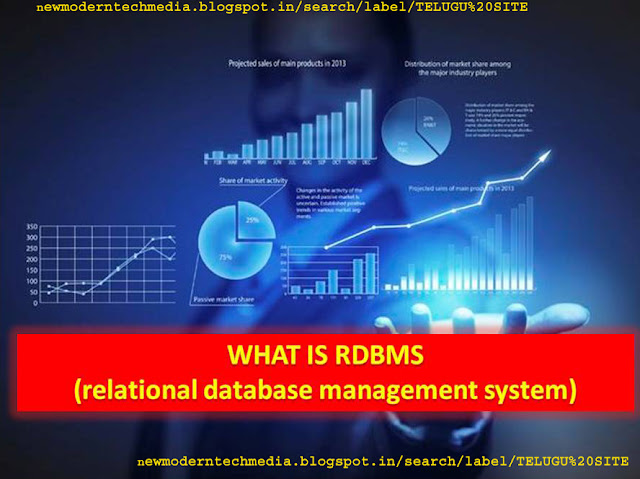What is RDBMS.?
RDBMS stands for Relational Database Management System. RDBMS is the basis for SQL, and for all modern database systems like MS SQL Server, IBM DB2, Oracle, MySQL, and Microsoft Access. A Relational database management system (RDBMS) is a database management system (DBMS) that is based on the relational model as introduced by E. F. Codd.
What is a table?
The data in an RDBMS is stored in database
objects which are called as tables. This table is basically a collection of
related data entries and it consists of numerous columns and rows. Remember, a table is the most common and simplest
form of data storage in a relational database. The following program is an
example of a CUSTOMERS table −
+----+----------+-----+-----------+----------+
| ID | NAME
| AGE | ADDRESS | SALARY |
+----+----------+-----+-----------+----------+
| 1 |
Surya |
18 | gorakhpoor | 2000.00 |
| 2 |
Suraj | 18 | Delhi |
1500.00 |
| 3 |
rohith |
18| Kota | 2000.00 |
| 4 |
preethi | 17| Mumbai | 6500.00 |
| 5
|deeksha| 17 | Bhopal |
8500.00 |
| 6 |
sravani | 17| MP |
4500.00 |
| 7 |
navya | 17| Indore | 10000.00 |
What is a field?
Every table is broken up into smaller entities
called fields. The fields in the CUSTOMERS table consist of ID, NAME, AGE,
ADDRESS and SALARY. A field is a column in a table that is designed
to maintain specific information about every record in the table.
What is a Record or a Row?
A record is also called as a row of data is each
individual entry that exists in a table. For example, there are 7 records in
the above CUSTOMERS table. Following is a single row of data or record in the
CUSTOMERS table −
+----+----------+-----+-----------+----------+
| 1 |
suraj |
18 | gorakhpoor | 2000.00 |
+----+----------+-----+-----------+----------+
A record is a horizontal entity in a table.
What is a column?
A column is a vertical entity in a table that
contains all information associated with a specific field in a table.
For example, a column in the CUSTOMERS table is
ADDRESS, which represents location description and would be as shown below −
+-----------+
| ADDRESS
|
+-----------+
| gorakhpoor |
| Delhi
|
| Kota
|
| Mumbai
|
| Bhopal
|
| MP
|
| Indore
|
+----+------+
What is a NULL value?
A NULL value in a table is a value in a field
that appears to be blank, which means a field with a NULL value is a field with
no value. It is very important to understand that a NULL
value is different than a zero value or a field that contains spaces. A field
with a NULL value is the one that has been left blank during a record creation.
SQL Constraints
Constraints are the rules enforced on data
columns on a table. These are used to limit the type of data that can go into a
table. This ensures the accuracy and reliability of the data in the database.
Constraints can either be column level or table
level. Column level constraints are applied only to one column whereas, table
level constraints are applied to the entire table.
Following are some of the most commonly used
constraints available in SQL −
NOT NULL Constraint − Ensures that a column
cannot have a NULL value.
DEFAULT Constraint − Provides a default value for
a column when none is specified.
UNIQUE Constraint − Ensures that all the values
in a column are different.
PRIMARY Key − Uniquely identifies each row/record
in a database table.
FOREIGN Key − Uniquely identifies a row/record in
any another database table.
CHECK Constraint − The CHECK constraint ensures
that all values in a column satisfy certain conditions.
INDEX − Used to create and retrieve data from the
database very quickly.
Data Integrity
The following categories of data integrity exist
with each RDBMS −
Entity Integrity − There are no duplicate rows in
a table.
Domain Integrity − Enforces valid entries for a
given column by restricting the type, the format, or the range of values.
Referential integrity − Rows cannot be deleted,
which are used by other records.
User-Defined Integrity − Enforces some specific
business rules that do not fall into entity, domain or referential integrity.
Database Normalization
Database normalization is the process of
efficiently organizing data in a database. There are two reasons of this
normalization process −
Eliminating redundant data, for example, storing
the same data in more than one table.
Ensuring data dependencies make sense.
Both these reasons are worthy goals as they
reduce the amount of space a database consumes and ensures that data is logically
stored. Normalization consists of a series of guidelines that help guide you in
creating a good database structure.
Normalization guidelines are divided into normal
forms; think of a form as the format or the way a database structure is laid
out. The aim of normal forms is to organize the database structure, so that it
complies with the rules of first normal form, then second normal form and
finally the third normal form.
It is your choice to take it further and go to
the fourth normal form, fifth normal form and so on, but in general, the third
normal form is more than enough.
First Normal Form (1NF)
Second Normal Form (2NF)
Third Normal Form (3NF)
There are many popular RDBMS available to work
with. This tutorial gives a brief overview of some of the most popular RDBMS’s.
This would help you to compare their basic features.
MySQL
MySQL is an open source SQL database, which is
developed by a Swedish company – MySQL AB. MySQL is pronounced as "my
ess-que-ell," in contrast with SQL, pronounced "sequel."
MySQL is supporting many different platforms
including Microsoft Windows, the major Linux distributions, UNIX, and Mac OS X.
MySQL has free and paid versions, depending on
its usage (non-commercial/commercial) and features. MySQL comes with a very fast,
multi-threaded, multi-user and robust SQL database server.
History
Development of MySQL by Michael Widenius &
David Axmark beginning in 1994.
First internal release on 23rd May 1995.
Windows Version was released on the 8th January
1998 for Windows 95 and NT.
Version 3.23: beta from June 2000, production
release January 2001.
Version 4.0: beta from August 2002, production
release March 2003 (unions).
Version 4.01: beta from August 2003, Jyoti adopts
MySQL for database tracking.
Version 4.1: beta from June 2004, production
release October 2004.
Version 5.0: beta from March 2005, production
release October 2005.
Sun Microsystems acquired MySQL AB on the 26th
February 2008.
Version 5.1: production release 27th November
2008.
Features
High Performance.
High Availability.
Scalability and Flexibility Run anything.
Robust Transactional Support.
Web and Data Warehouse Strengths.
Strong Data Protection.
Comprehensive Application Development.
Management Ease.
Open Source Freedom and 24 x 7 Support.
Lowest Total Cost of Ownership.
MS SQL Server
MS SQL Server is a Relational Database Management
System developed by Microsoft Inc. Its primary query languages are −
T-SQL
ANSI SQL
History
1987 - Sybase releases SQL Server for UNIX.
1988 - Microsoft, Sybase, and Aston-Tate port SQL
Server to OS/2.
1989 - Microsoft, Sybase, and Aston-Tate release
SQL Server 1.0 for OS/2.
1990 - SQL Server 1.1 is released with support
for Windows 3.0 clients.
Aston - Tate drops out of SQL Server development.
2000 - Microsoft releases SQL Server 2000.
2001 - Microsoft releases XML for SQL Server Web
Release 1 (download).
2002 - Microsoft releases SQLXML 2.0 (renamed
from XML for SQL Server).
2002 - Microsoft releases SQLXML 3.0.
2005 - Microsoft releases SQL Server 2005 on
November 7th, 2005.
Features
High Performance
High Availability
Database mirroring
Database snapshots
CLR integration
Service Broker
DDL triggers
Ranking functions
Row version-based isolation levels
XML integration
TRY...CATCH
Database Mail
ORACLE
It is a very large multi-user based database
management system. Oracle is a relational database management system developed
by 'Oracle Corporation'.
Oracle works to efficiently manage its resources,
a database of information among the multiple clients requesting and sending
data in the network.
It is an excellent database server choice for
client/server computing. Oracle supports all major operating systems for both
clients and servers, including MSDOS, NetWare, UnixWare, OS/2 and most UNIX
flavors.
History
Oracle began in 1977 and celebrating its 32
wonderful years in the industry (from 1977 to 2009).
1977 - Larry Ellison, Bob Miner and Ed Oates
founded Software Development Laboratories to undertake development work.
1979 - Version 2.0 of Oracle was released and it
became first commercial relational database and first SQL database. The company
changed its name to Relational Software Inc. (RSI).
1981 - RSI started developing tools for Oracle.
1982 - RSI was renamed to Oracle Corporation.
1983 - Oracle released version 3.0, rewritten in
C language and ran on multiple platforms.
1984 - Oracle version 4.0 was released. It
contained features like concurrency control - multi-version read consistency,
etc.
1985 - Oracle version 4.0 was released. It
contained features like concurrency control - multi-version read consistency,
etc.
2007 - Oracle released Oracle11g. The new version
focused on better partitioning, easy migration, etc.
Features
Concurrency
Read Consistency
Locking Mechanisms
Quiesce Database
Portability
Self-managing database
SQL*Plus
ASM
Scheduler
Resource Manager
Data Warehousing
Materialized views
Bitmap indexes
Table compression
Parallel Execution
Analytic SQL
Data mining
Partitioning
MS ACCESS
This is one of the most popular Microsoft
products. Microsoft Access is an entry-level database management software. MS
Access database is not only inexpensive but also a powerful database for
small-scale projects.
MS Access uses the Jet database engine, which
utilizes a specific SQL language dialect (sometimes referred to as Jet SQL).
MS Access comes with the professional edition of
MS Office package. MS Access has easyto-use intuitive graphical interface.
1992 - Access version 1.0 was released.
1993 - Access 1.1 released to improve
compatibility with inclusion the Access Basic programming language.
The most significant transition was from Access
97 to Access 2000.
2007 - Access 2007, a new database format was
introduced ACCDB which supports complex data types such as multi valued and
attachment fields.
Features
Users can create tables, queries, forms and
reports and connect them together with macros. Option of importing and
exporting the data to many formats including Excel, Outlook, ASCII, dBase,
Paradox, FoxPro, SQL Server, Oracle, ODBC, etc. There is also the Jet Database
format (MDB or ACCDB in Access 2007), which can contain the application and
data in one file. This makes it very convenient to distribute the entire
application to another user, who can run it in disconnected environments.
Microsoft Access offers parameterized queries. These queries and Access tables
can be referenced from other programs like VB6 and .NET through DAO or ADO. The
desktop editions of Microsoft SQL Server can be used with Access as an
alternative to the Jet Database Engine. Microsoft Access is a file server-based
database. Unlike the client-server relational database management systems
(RDBMS), Microsoft Access does not implement database triggers, stored
procedures or transaction logging.
Note: Everyone can share the useful article





